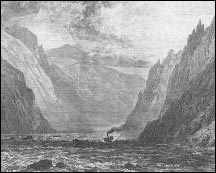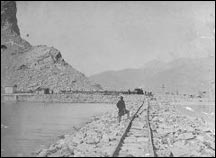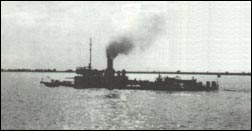
Avalanche Press
Presents
| Romanian
Danube Flotilla The broad Danube River became a means of projecting military power as far back as Roman times, when a flotilla of warships supported campaigns against the Dacians. Later, Turkish and Austrian warships fought for control of the Danube, usually above the deadly rapids of the Iron Gates. Below them, Turkish river gunboats controlled the waterway. In 1899 the ship canal bypassing the Iron Gates was completed, and three years later the Sulina “cut off” canal entered service. The Danube now became an economic artery stretching from southern Germany to the Black sea – and an important outlet for the Austro-Hungarian Empire. Austria had constructed a small fleet of armored river monitors, and in 1907, Romania followed.
For river craft, these were large and powerful warships, mounting three 120mm guns in turrets, plus two more 120mm howitzers, and four 47mm guns. Armor protection was very good for a river craft: three inches on the belt, turrets and deck, two inches on the conning tower, better than most tanks until the last years of World War II. They had a crew of 110, a speed of 12 knots (all they needed for river duty) and drew only 1.6 meters of water.
Three former Austro-Hungarian monitors were obtained in 1920, all of which had seen much harder service in the much more active Austrian flotilla (which even ventured into the Black Sea and along Ukraine’s rivers in 1918). Ardeal was the former Austrian Temes, mined and sunk in 1914 but raised in 1916. In her initial Romanian configuration she had three 120mm guns, but was also rebuilt in 1937-38 at Galati, landing her aft turret and receiving a fairly heavy anti-aircraft armament — six 37mm and four 20mm guns, further augmented during the war. Built at Linz in Austria, she was smaller than the original Romanian monitors (450 tons) and slightly slower, but drew less water.
In addition to the seven monitors, the Romanians operated about a dozen patrol boats, most of them fitted as either torpedo boats or river minesweepers. In 1941, Romania boasted the world’s most powerful riverine naval force. Officially part of the Navy, personnel rarely transferred between the Danube Division and the Maritime Division, each operating more or less as a distinctive branch of service. The Danube Division did not live up to its potential during the war; the monitors skirmished with the Soviet Danube Flotilla in the war’s opening days but did not directly challenge their enemies, as the rapid advance on land assured that the Soviets would have to withdraw soon regardless of Romanian actions on the river. Once they did so, unlike the Austrians in 1918 the Romanians ignored German requests to send their monitors eastward to ply Ukraine’s rivers. They remained at home to defend Romanian territory, and two were lost to Soviet air attack in August 1944. The remainder were seized by the Soviets and operated in Hungary as part of the revived Soviet Danube Flotilla. Returned after the war, the five survivors plus the two salvaged from the river bottom served as training ships into the late 1950s, and all had been scrapped by 1961. While the Romanian monitors theoretically would have fought their Soviet opposite numbers, their real purpose was to provide mobile, armored fire support along the river banks. Forward fire controllers would be put ashore to direct the gunnery by radio, making the monitors the most efficient artillery asset possessed by Romania in 1941 (army batteries, even the handful with modern French-built guns, still relied on vulnerable telephone lines). The flotilla also included a company of Marines, to be landed in platoon-sized battle groups to protect the fire control teams. The Romanian monitors are valuable fire support assets to the Axis player in Red Steel, but we definitely undervalued them — the seven monitors are grouped into two river-bound artillery support units. Their strength is about right for a single monitor (which should be roughly equivalent to the destroyers found in Invasion of Italy). Therefore, we’ve included a free download of new monitor counters here. All regular game rules apply: simply substitute the seven new units for the two in the current game. You’ll be glad you did. |
© Avalanche Press LTD, all rights reserved.


